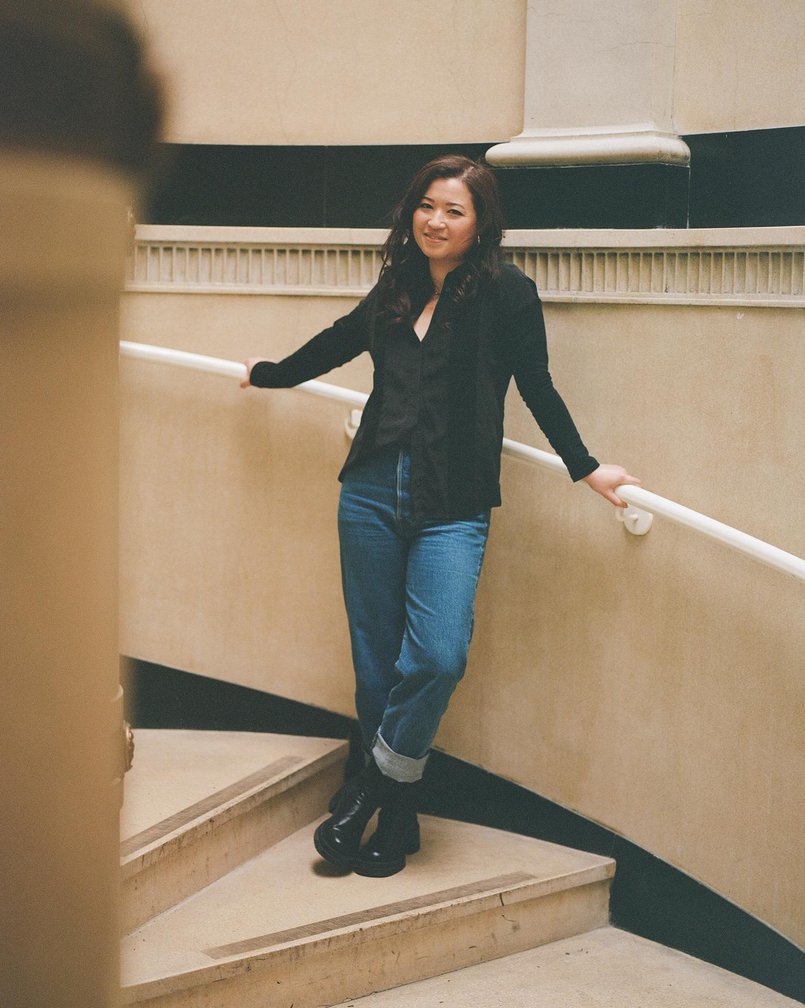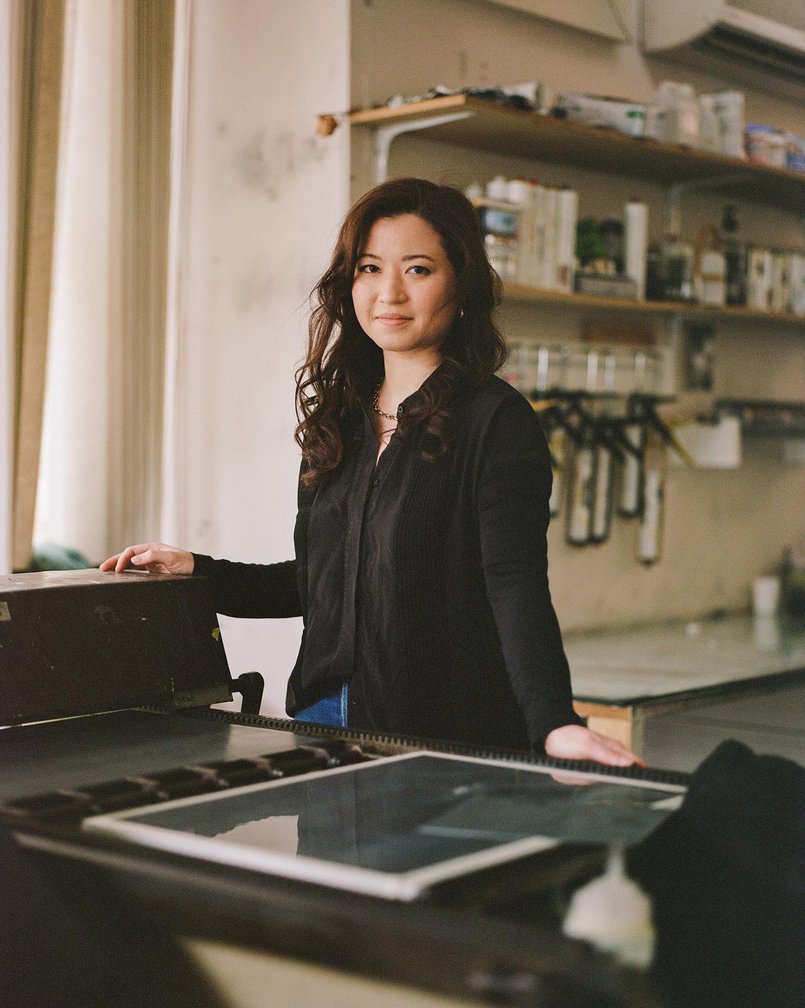article In conversation with
Kristina Chan
In conversation with
Kristina Chan
Kristina Chan

In conversation with Kristina Chan
about the landscape as a metaphor
and the journey from bronze
casting to printmaking.
about the landscape as a metaphor
and the journey from bronze
casting to printmaking.
In conversation with Kristina Chan
about the landscape as a metaphor
and the journey from bronze
casting to printmaking.
Kristina Chan is a London-based artist working between printmaking, photography and public installation. Her practice utilises narrative and site specificity to evoke a felt history and sense of place. Inspired by post-impressionism, Japanese prints, and contemporary photography, her work explores the boundaries between individual and collective memory and how these colliding narratives affect our interpretation of space.
Kristina's studio is based in an old County Court in South London, and we visited her here in the summer to learn more about her practice.
Kristina's studio is based in an old County Court in South London, and we visited her here in the summer to learn more about her practice.

Artiq What site or place has had the most significant influence on your recent work? Why?
Kristina Remote and endangered environments have been a long source of inspiration for my work. Most recently, I have released a series based on volcanic landscapes. I am interested in presumably untouched places. They have this assumption, or air about them, but upon closer look are in fact some of the places most affected by the climate crisis, where the effects are most visible.
Artiq Many of your works are placed in public spaces, such as Petrichor and your piece within the Shakespeare Art Trail. How do you feel about showing work in public spaces, as opposed to within art galleries? Do you think that there is a difference in the way that the art is understood and read?
Kristina The public space is an entirely different venue to show art. It allows for an entirely different experience all together. There’s an interaction to it and approachability. It is to be seen by all, outside the formality of the gallery. That’s what I love about it.
Artiq You work with a variety of mediums in your practice, from photography and printmaking to sculpture and metal-casting. Could you speak a bit more about your multimedia approach? Do any of these mediums come most naturally to you?
Kristina For me, it’s all about the language and how you want to convey a concept that dictates the medium. Oddly enough, I originally trained in sculpture, especially bronze casting. But also found the chemistry relatable across printmaking and photography. I think really, it’s the image that dictates the medium.
Kristina Remote and endangered environments have been a long source of inspiration for my work. Most recently, I have released a series based on volcanic landscapes. I am interested in presumably untouched places. They have this assumption, or air about them, but upon closer look are in fact some of the places most affected by the climate crisis, where the effects are most visible.
Artiq Many of your works are placed in public spaces, such as Petrichor and your piece within the Shakespeare Art Trail. How do you feel about showing work in public spaces, as opposed to within art galleries? Do you think that there is a difference in the way that the art is understood and read?
Kristina The public space is an entirely different venue to show art. It allows for an entirely different experience all together. There’s an interaction to it and approachability. It is to be seen by all, outside the formality of the gallery. That’s what I love about it.
Artiq You work with a variety of mediums in your practice, from photography and printmaking to sculpture and metal-casting. Could you speak a bit more about your multimedia approach? Do any of these mediums come most naturally to you?
Kristina For me, it’s all about the language and how you want to convey a concept that dictates the medium. Oddly enough, I originally trained in sculpture, especially bronze casting. But also found the chemistry relatable across printmaking and photography. I think really, it’s the image that dictates the medium.

Artiq You have recently opened a solo exhibition, titled ‘Fault Lines’, at the Hancock Gallery. Congratulations! Can you tell us a bit more about the show? What was the highlight of the experience?
Kristina Fault Lines has been an amazing experience. Working with the Hancock Gallery is always wonderful. They have been so supportive every step of the way. The show itself is one of the largest bodies of work I’ve done to date, with imagery spanning 3 continents and 4 countries. The work explores landscapes along various tectonic rifts and how they affect various environments. It spans oases, deserts, tropical and temperate rainforests and encompasses printmaking, photography and sculpture.
Artiq A lot of your work includes plant imagery and natural references, such as within the exhibition ‘Adrift’ at the Lightbox Gallery. Could you explain a bit more about why you are drawn to this type of imagery?
Kristina The landscape serves as a metaphor, illuminating a scale of deep time we are not confronted with in our day to day. It represents a cycle of renewal and regrowth, amongst the effects of invasive species, natural disaster, and human impact.
Artiq What are you currently working on? Do you have any exciting projects coming up that you would like to share with us?
Kristina Most immediately, I am excited to announce I will be exhibiting at Asia Now, Paris with the Frestonian Gallery in October. I am also working on a much larger longer-term project looking at the narratives of arctic landscapes that will launch in the summer 2024 with a research trip to the Arctic Circle.
Kristina Fault Lines has been an amazing experience. Working with the Hancock Gallery is always wonderful. They have been so supportive every step of the way. The show itself is one of the largest bodies of work I’ve done to date, with imagery spanning 3 continents and 4 countries. The work explores landscapes along various tectonic rifts and how they affect various environments. It spans oases, deserts, tropical and temperate rainforests and encompasses printmaking, photography and sculpture.
Artiq A lot of your work includes plant imagery and natural references, such as within the exhibition ‘Adrift’ at the Lightbox Gallery. Could you explain a bit more about why you are drawn to this type of imagery?
Kristina The landscape serves as a metaphor, illuminating a scale of deep time we are not confronted with in our day to day. It represents a cycle of renewal and regrowth, amongst the effects of invasive species, natural disaster, and human impact.
Artiq What are you currently working on? Do you have any exciting projects coming up that you would like to share with us?
Kristina Most immediately, I am excited to announce I will be exhibiting at Asia Now, Paris with the Frestonian Gallery in October. I am also working on a much larger longer-term project looking at the narratives of arctic landscapes that will launch in the summer 2024 with a research trip to the Arctic Circle.